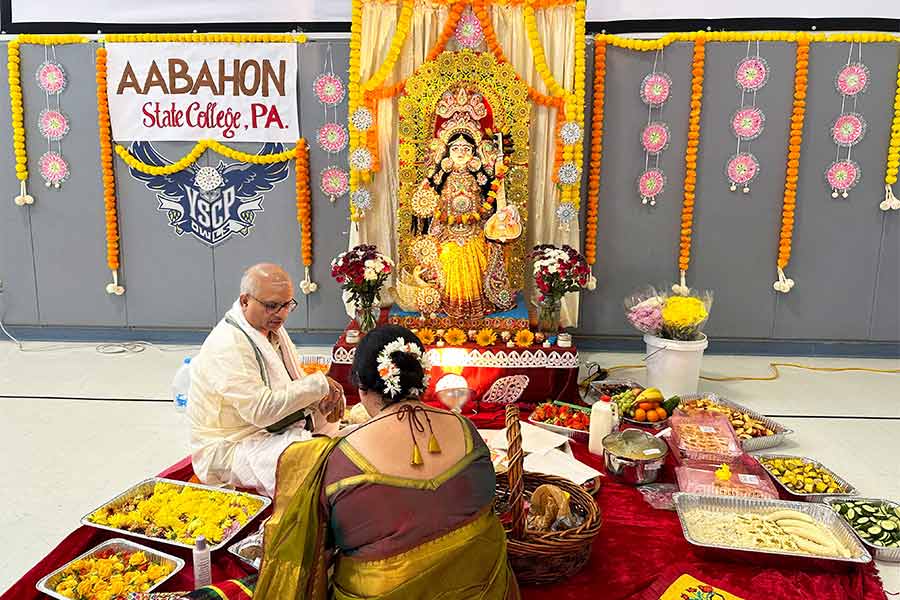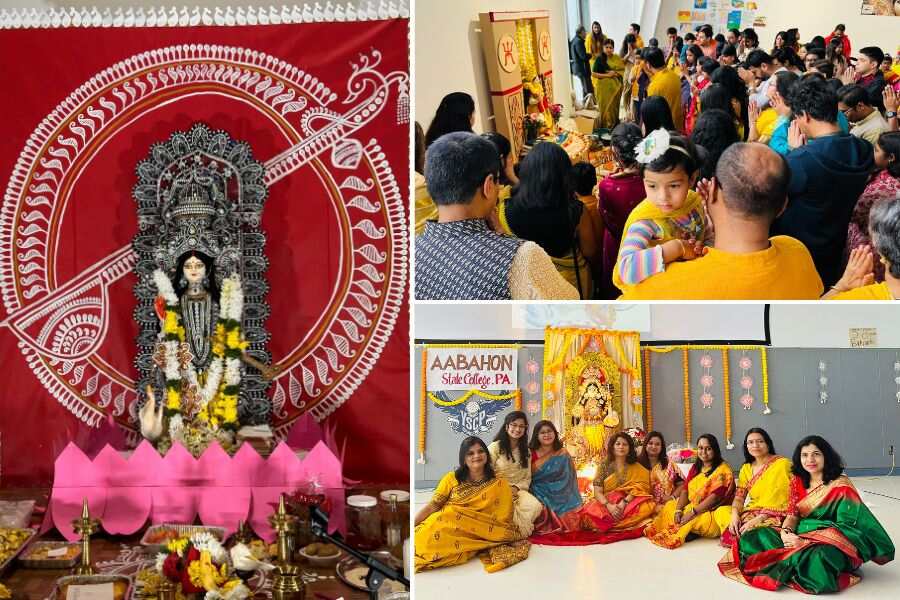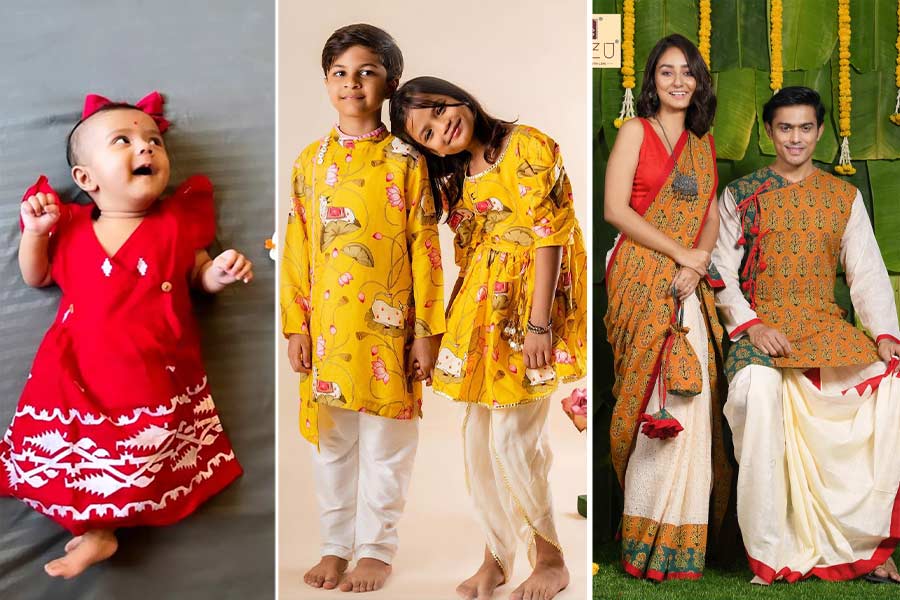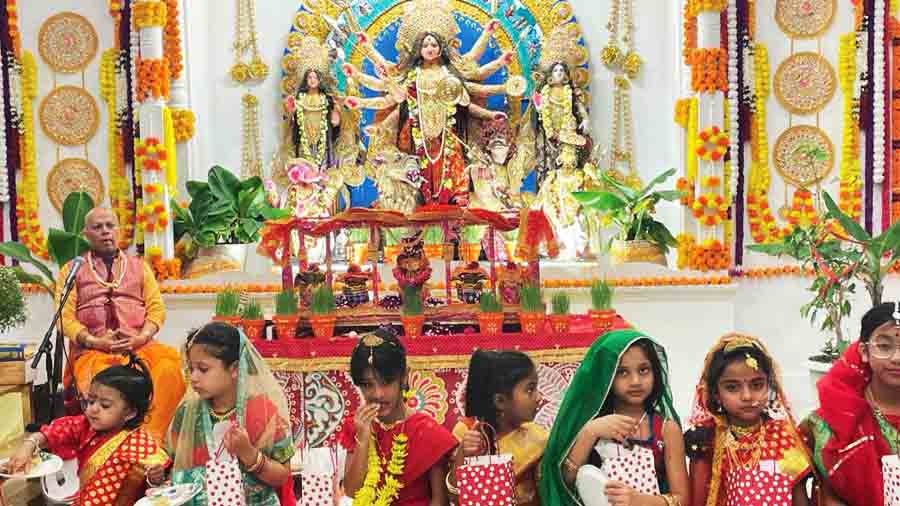Having grown up with Saraswati Puja being celebrated in his home in Malamba, Burdwan, homesickness is a bitter pang for Amlan Datta, a third-year PhD student in Physics at Iowa State University, during Vasant Panchami. However, his newfound community at college, that comes together to celebrate a puja away from home, helps him through it.
Saraswati Puja has always been of particular importance to students growing up in West Bengal. Even the most irreverent of students find themselves divinely inspired, and keeping books, harmoniums, tablas, and ghungroos at the feet of Ma Saraswati for her blessings is as much part of the festivities as dressing up in saris and panjabis in various shades of yellow and offering anjali in the morning. Pushpanjali followed by bhog and adda, comprise a day that provides respite from the innumerable struggles of being a student.
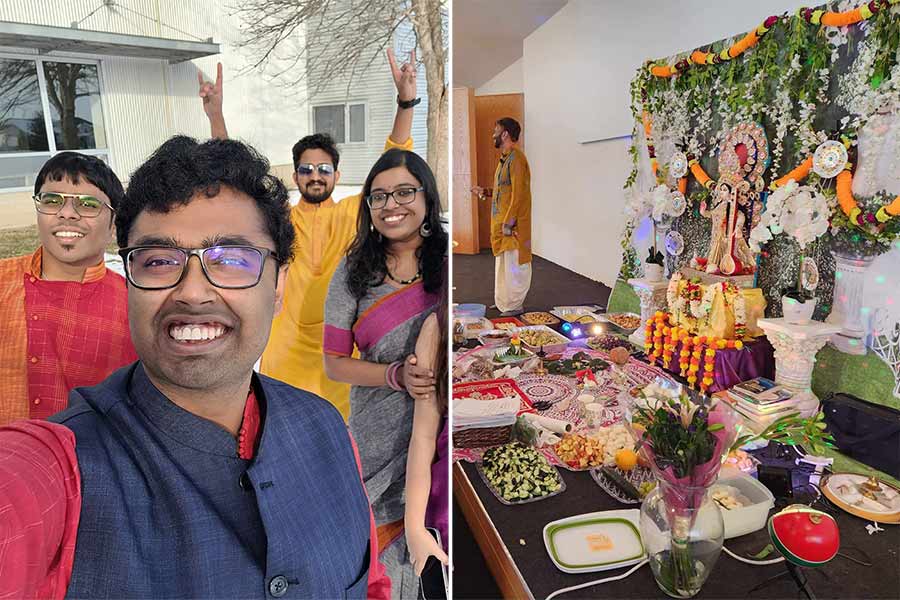
Amlan Datta with his friends during Saraswati Puja in Iowa, and (right) ‘pushpanjali’ in progress at the puja
Courtesy Amlan DattaLife takes Bengali students away from home but wanting to experience the festivities that made up much of their childhoods is always present. That is when they form their own communities to celebrate Saraswati Puja with much of the same ingredients as back home — friendship, inclusion, and warmth.
My Kolkata caught up with students and members of various organisations in the United States and Germany to talk about how they celebrate Saraswati Puja in their own unique ways.
Home away from home
In Iowa, a homesick Amlan found familiarity and comfort with his prabashi community, and discovered the enthusiasm with which the resident Bengali community celebrates Vasant Panchami. “Our senior faculties are more active than the graduate students but all of us step up to do our bit and make the puja a success.”
Something similar happened with Soumi Mukherjee, a fourth-year PhD student of Biology at Purdue University, who found home away from home with the communities of two Bengali associations: West Lafayette Durga Puja Association (WLDA) and Purdue University Tagore Society (PUTS). While WLDA is a nonprofit comprising professors, their family members, and other Bengalis in West Lafayette, the Purdue University Tagore Society (PUTS) is a student organisation. A restriction from the university prevents PUTS from celebrating religious ceremonies on campus but that doesn’t stop the students from enjoying them. The students volunteer with WLDA to make every puja a success.
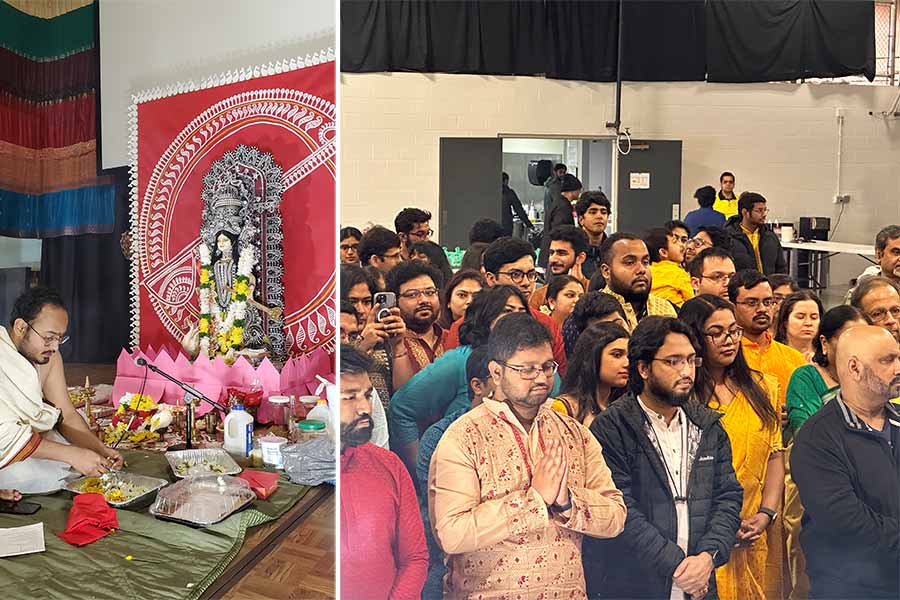
The Saraswati Puja at West Lafayette Durga Puja Association
Courtesy Soumi Mukherjee“Just like the bonedi bari pujos in West Bengal, we consider Saraswati Puja at WLDA to be our own. This puja has been happening for the last 40 years and we try to follow all the rituals. Someone from the families (associated with WLDA) conducts the rituals, others oversee finances, while students handle the preparations. We usually have the puja on a weekend and students from Indiana and Kentucky also visit, drawn by the homeliness of it. Thanks to this community, I don't miss Kolkata; it’s become a home away from home,” said Mukherjee, who is currently the vice-president of PUTS.
Avik Kumar Ojha, a second-year PhD student of Chemistry at The Ohio State University and treasurer of the Buckeye Bengalis, had a similar story to share. The organisation raises funds through a ticketing system and a substantial amount also comes from the university. Here, too, a community of students and residents comes together to celebrate.
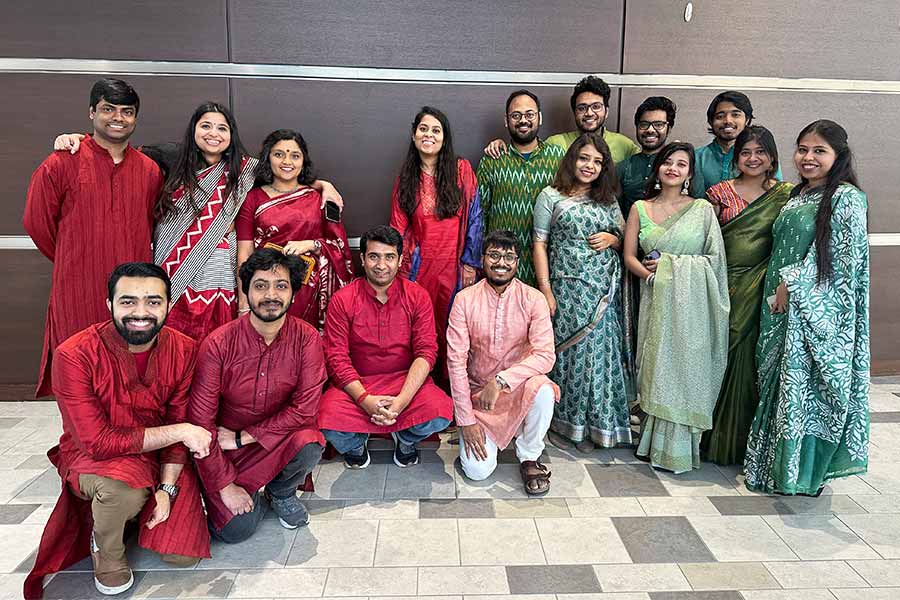
Members of the community at Buckeye Bengalis
Courtesy Avik Kumar Ojha“In the mornings, one of the senior students performs the puja, while the majority of the bhog is also cooked by the students the previous night. In the evenings, different artistes perform, and for the last three years, because of COVID restrictions, we have had singers such as Abhijit Barman (Pota, from Cactus), Somlata Acharyya Chowdhury, and Rupam Islam performing from Kolkata as we watched via YouTube Live. We have had professors and their families participate along with students from different universities. A lot of children come to the puja and they are usually very excited,” explained Ojha. This year the Buckeye Bengalis will celebrate Saraswati Puja on February 24.
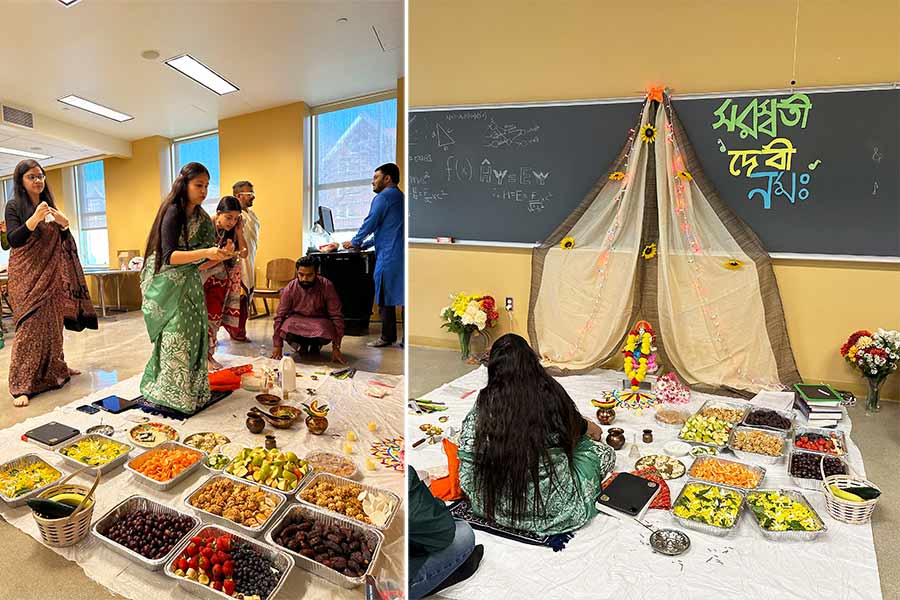
The puja at The Ohio State University
Courtesy Avik Kumar OjhaInclusion is key
The community of Gainesville Bengali Association, Florida is not a big one, but that doesn’t diminish the fervour of their Vasant Panchami celebrations. “Dola jethi (Sreemati Ghosh), a senior resident of Gainsville, makes all the preparations for the puja, and the students of the University of Florida take care of the decorations and some of the cooking along with the senior members. But the specialty is that several people from different religious and cultural backgrounds also participate in the puja,” said Sroyon Sengupta, a second-year PhD student in Mathematics from the University of Florida.

The Saraswati Puja by Gainesville Bengali Association
Courtesy Sroyon SenguptaInclusion has also been of primary importance to Durgaville, a Bengali community in the city of Erlangen, Germany. This year is special for the Indian community in Erlangen because the city is supporting all of its activities and funding a majority of them in a bid to showcase the city’s diversity. Durgaville will be conducting the Saraswati Puja on February 14, which will be open to all.
“I came to Erlangen in 2008 after marriage. At that time there weren’t many Indians and there was just one club called Namaste Club, which didn’t have many Bengalis. Three families, mine being one of them, started Durgaville and each year we are adding more members. The interesting bit is that our idol is handmade by Dipankar Sarkar, a tech professional and one of the founding members,” said Gargi Bhattacharyya, one of the founding members of Durgaville.
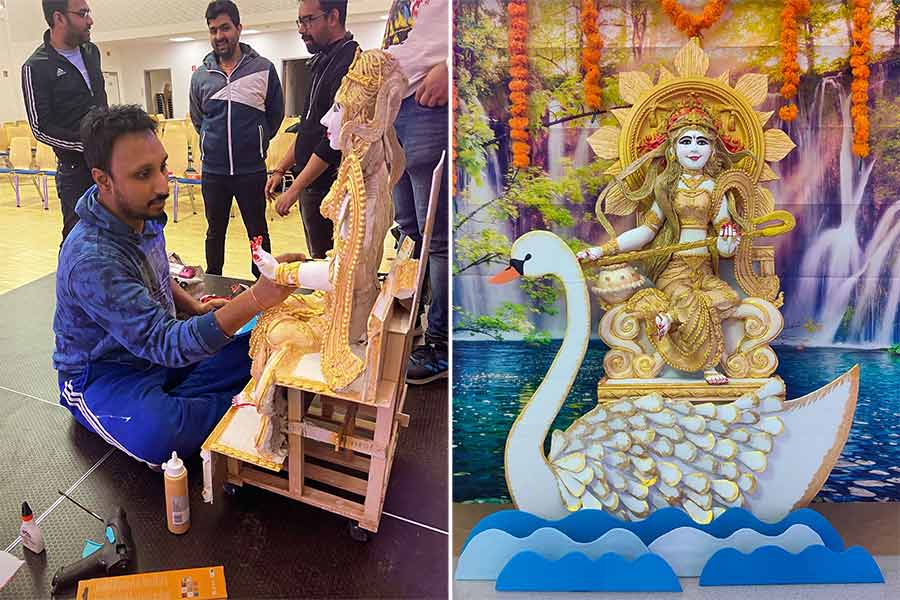
Dipankar Sankar painting the Saraswati idol for the puja by Durgaville
Courtesy Gargi BhattacharyyaArka Acharya, a master’s student at Friedrich-Alexander-Universität (Erlangen-Nürnberg), is especially looking forward to the puja this year, especially the cultural functions. “A Ukrainian dance club approached us this time and they will stage a Kathak performance and a fusion of Bollywood and Indian classical dance forms. Not only that, another Russian woman will be enchanting us with a Saraswati vandana. We are also excited about the performance of our new student’s theatre group Shesh Mesh,” he said.
A celebration of culture
Only a year old, Kheyal is the first exclusive Bengali association at the University of Chicago. Kheyal’s aim had always been to make people aware of Bengali culture, so for them, the cultural aspect of the puja takes precedence over the ritualistic one.
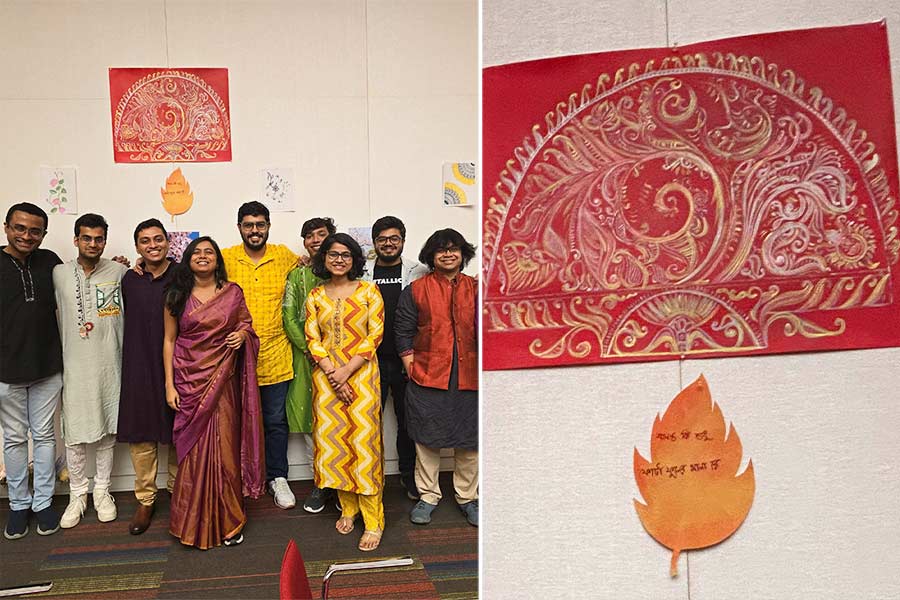
Core committee members at Kheyal, and (right) the ‘alpona’ and decorations during the puja
Courtesy Soumik Ghosh“We celebrate Rabindra Jayanti, Durga Puja, and recently we also celebrated Basanta Utsob,” said Soumik Ghosh, a fourth-year PhD student at the University of Chicago and the co-founder and president of Kheyal, which he started with three of his friends Aabesh Bhattacharyya, Anchita Addhya, and Tamsuk Paul. They have recently been registered as a student community and their aim is to promote Bengali culture within the university community and in Chicago.
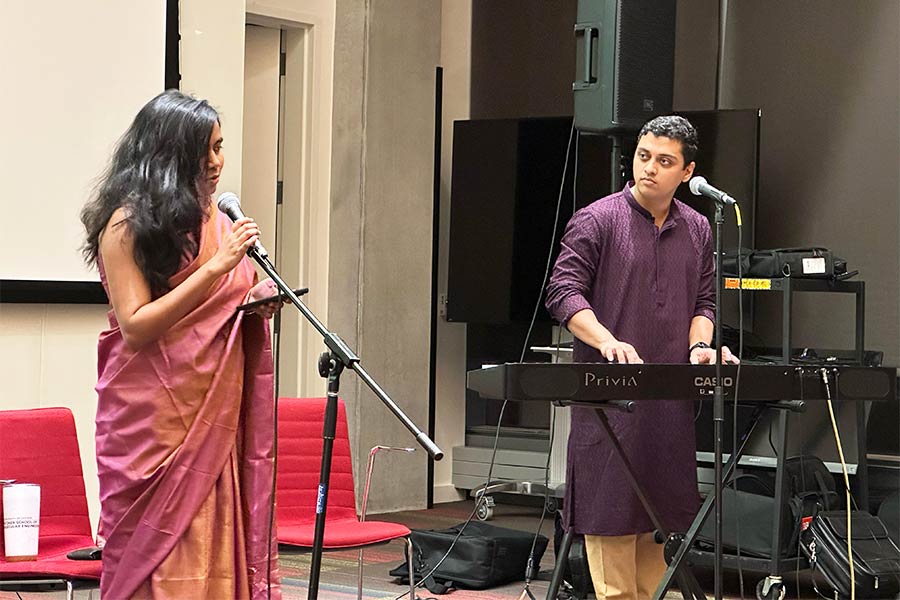
Students performing during the Saraswati Puja by Kheyal
Courtesy Soumik Ghosh“We want to carve a niche for Bengalis in Chicago so that we can be a part of the mainstream. We celebrate Basanta Utsob in the manner in which it is celebrated in Santiniketan. The alpona, led by Tannistha Mondal, a first year PhD student in Statistics — who also led the Durga Puja decorations and the sculpting of a hand-made Durga Idol — was inspired by the style of artist Nandalal Bose. We also had colourful pictures and calligraphy by Sulagna Ghosh, Anchita Addhya, Pratyasha Chakraborty, Tamsuk Paul, and Kuntal Ghosh— all PhD students across different departments on campus,” he added.
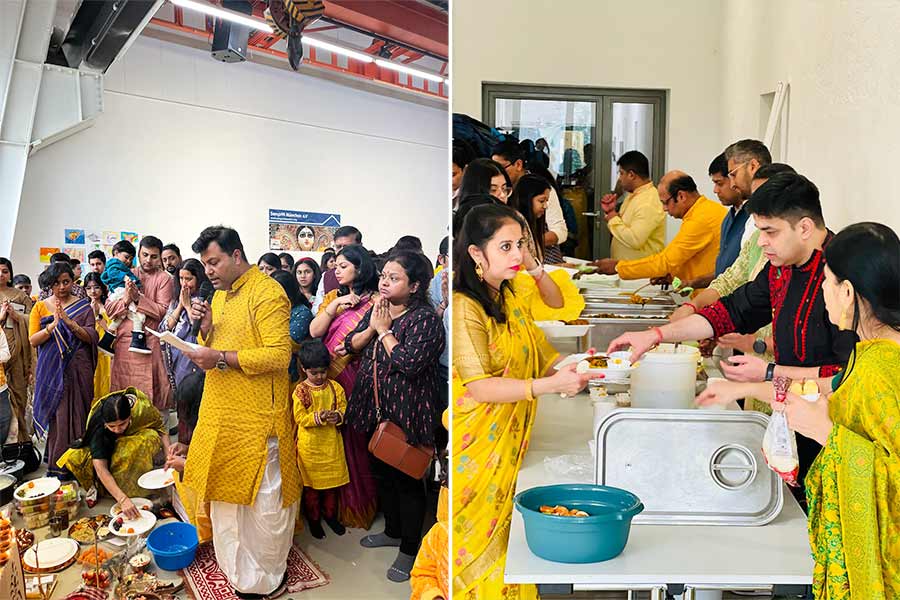
The Saraswati Puja by Sampriti München e.V in Munich, and (right) bhog being served by members
Courtesy Anubhab DasguptaSharing and promoting Bengali culture has also been the aim of Sampriti München e.V, a Bengali community in Germany’s Munich. The first Saraswati Puja was held in 2018. In December 2017, the idol was brought to Germany from Kalighat by the former president of the community, Shaibal Giri, and the first puja was held in a church. For this community, the celebration of culture and religion have always intertwined.
“When we were young, we would do everything ourselves throughout the night for the Saraswati Puja in Kolkata. Here as well, we clean the hall, create the stage, and decorate the previous night. Since we do not have the puja on the actual day, we are usually a little flexible with time,” said Anubhab Dasgupta, the secretary of the community about the celebrations in Munich. There are three rounds of pushpanjali, followed by cultural programmes, and children are encouraged to participate in the events and one of the most integral parts of the puja is haathe khodi. “Every year, at least seven or eight kids have their haathe khodi at our puja,” he added. The community celebrates their culture in many fun ways as well, such as with “games similar to the ones that we have during a bashi biye — men have to wear saris and women have to knot neckties.”
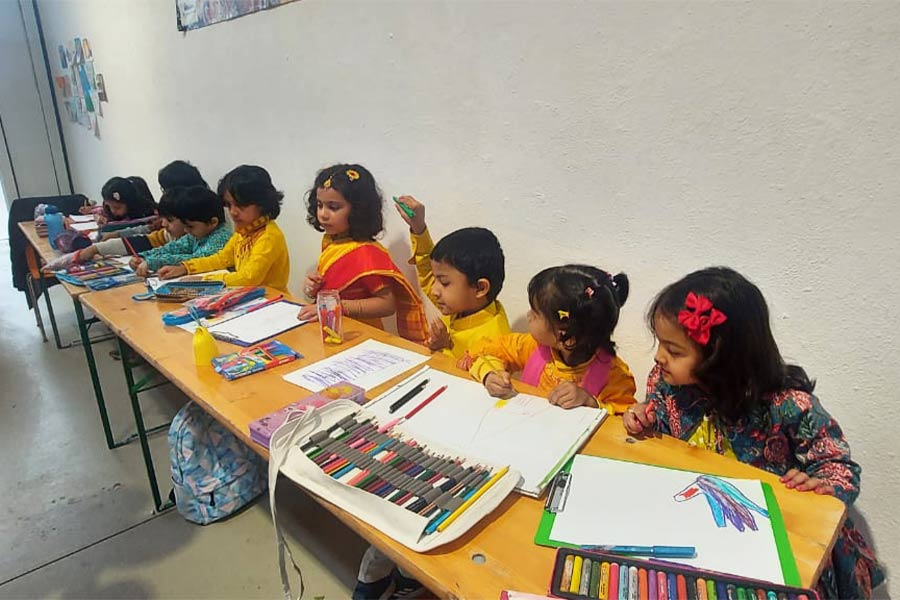
Children participating in a drawing competition at the puja in Munich
Courtesy Anubhab DasguptaAcross continents, the probashi Bangalis come together to relive the nostalgic memories of their childhoods and celebrate their culture. The common thread, and perhaps the most important aspect of the pujas, is the community and friendships that grow along the way.
That certainly is the case for Ritam Pal, a third-year PhD student in Mechanical Engineering at The Pennsylvania State University. “The fact that everyone in Aabahon (formerly known as State College Bengali Students’ Association) is closely knit makes it so much more special. Everyone is just a call away and the Saraswati Puja is a reminder of the friendships that we share,” he signed off.
